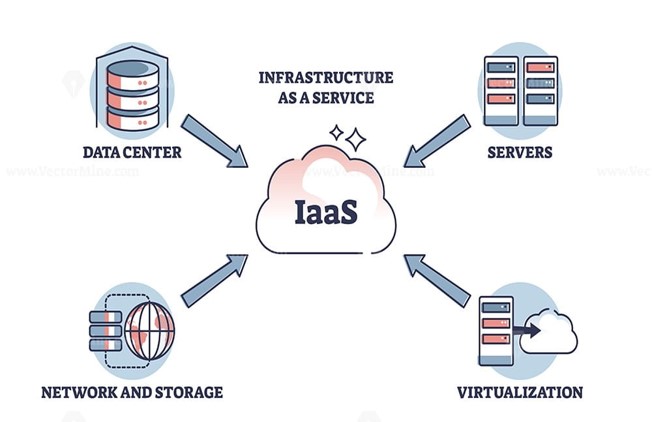
IaaS (Infrastructure as a Service)
IaaS stands for Infrastructure as a Service. In simple terms, it’s a cloud computing service that provides virtualized computing infrastructure over the internet. Instead of owning and maintaining physical servers, businesses can rent virtual servers, storage, and networking resources on a pay-as-you-go basis. This allows for greater flexibility and scalability, as users can easily scale their infrastructure up or down based on their needs without the burden of managing hardware.
Characteristics Of IaaS
In the infrastructure-as-a-service (IaaS) model, all other technology stack components are established and maintained by the subscriber, who only leases the hardware infrastructure (networking, servers, storage, data center space, and virtualization services).
1. Resources-as-a-service
The cloud service model is based on the concept of resources-as-a-service. As an alternative to spending money on the up-front equipment costs associated with creating and managing a server room or data center, the cloud service model allows organizations to access and implement IT infrastructure with a subscription-based payment model that’s more affordable.
2. Pay-as-you-go pricing model
IaaS services are provided on an on-demand basis and billed on a pay-as-you-go basis, making them a cost-efficient option for smaller organizations that can only afford to pay for the computing resources they use. An IaaS provider might bill according to the number of virtualization instances created or based on the quantity of data stored.

3. Scalable services
The ability to quickly and easily scale service is one of the major benefits of the IaaS model. Cloud service providers maintain data centers with large volumes of servers and data storage available, which can be apportioned to a customer upon request.
This significantly cheapens and simplifies the process of scaling up IT infrastructure for subscribers to IaaS services compared to organizations that deploy IT infrastructure in an on premise data center.
4. Automated administrative tasks
IT organizations that manage data centers and hardware infrastructure in the on premise model are responsible for routine updates, patches, and maintenance activities that can affect the availability of hardware resources and the software applications that depend on them. In contrast, IaaS service providers handle upgrades and maintenance to their servers without compromising infrastructure availability for customers.
5. Platform virtualization
Platform virtualization refers to creating a virtual machine that acts as a logical abstraction of a hardware platform. The main purpose of virtualization is to divide the resources of a mainframe computer between different functions and applications and to segment those environments from each other for operational or testing purposes. Platform virtualization enables IaaS subscribers to deploy virtualized computing instances as needed to support software development and other tasks.
ROLE OF IaaS
Infrastructure as a Service (IaaS) plays a crucial role in modernizing and simplifying the way businesses manage their IT infrastructure. It allows organizations to rent virtualized computing resources, such as servers, storage, and networking, on a flexible and scalable basis. With IaaS, businesses can avoid the upfront costs and complexities of owning and maintaining physical hardware. This cloud computing model enables them to scale their infrastructure up or down based on their needs, pay only for the resources they use, and benefit from the service provider’s management of underlying hardware.
IMPORTANCE OF IaaS
Infrastructure as a Service (IaaS) is vital for businesses seeking flexibility, scalability, and cost-efficiency in managing their IT infrastructure. By allowing organizations to rent virtualized computing resources instead of investing in and maintaining physical hardware, IaaS minimizes upfront costs and simplifies the management of IT systems. This cloud computing model enables businesses to easily scale their infrastructure based on demand, paying only for the resources utilized. The importance of IaaS lies in its ability to provide a dynamic and responsive foundation for digital operations, allowing companies to focus on their core activities, innovate more rapidly, and adapt quickly to changing business requirements.
BENEFITS OF IaaS
Here are the benefits of Infrastructure as a Service (IaaS):
Cost Efficiency: Pay for only the resources you use, avoiding upfront hardware expenses.
Scalability: Easily scale up or down based on demand, accommodating business growth.
Flexibility: Adapt quickly to changing needs with customizable virtualized resources.
Managed Infrastructure: Offload the burden of hardware maintenance to the service provider.
Accessibility: Access and manage your infrastructure from anywhere with an internet connection.
Rapid Deployment: Quickly deploy and configure resources, accelerating time-to-market for projects.

Resource Optimization: Efficiently allocate computing power, storage, and networking to meet specific requirements.
Focus on Core Competencies: Shift focus from infrastructure management to core business activities and innovation.
JOB ROLES OF IaaS
1. Cloud Architect: Designs cloud infrastructure
2. Systems Administrator: Manages virtualized servers and storage.
3. Network Engineer: Designs and maintains cloud network.
4. Security Specialist: Ensures IaaS security.
5. DevOps Engineer: Automates deployment processes.
6. Cloud Consultant: Advises on IaaS adoption.
7. Support Engineer: Provides technical assistance.
8. Data Engineer: Manages cloud data storage.
9. Compliance Analyst: Ensures regulatory adherence.
10. IT Manager/Director: Oversees IaaS strategy.
SALARY
The salary is between 13LPA To 35LPA.
TOOLS OF IaaS
Ansible: It is a simple IT automation engine. It is a powerful tool and is enough to automate complex multi-tier IT application environments.
Virtualization: Simulates hardware for running multiple virtual machines.
Hypervisors: Manages virtual machines on physical servers.
Storage Virtualization: Abstracts and manages storage resources.
SDN (Software-Defined Networking): Programmable and flexible network configurations.
Load Balancing: Distributes network traffic for optimal resource use.
Containers: Lightweight, portable application deployment.
Automation Tools: Streamlines resource provisioning and management.
Monitoring Tools: Monitors performance for efficient operation.
APIs (Application Programming Interfaces): Enables seamless interaction with cloud services.
Orchestration Tools: Coordinates deployment of multiple cloud resources.

SaltStack: SaltStack is a remote-execution tool that allows administrators to run commands against a remote server and automatically manage any infrastructure application at scale.
CFEngine: It is widely known as the godfather of configuration management tools and automation framework. This tool is quite popular among top cloud computing service providers in the world.
Docker: It is a lightweight open-source containerization technology that automates the deployment of applications in containers. Majorly, it is used to create and run Linux containers.
Amazon Web Services (AWS): AWS is the market leader in IaaS cloud computing, providing businesses access to a wide range of compute, storage, and networking services.
Microsoft Azure: Microsoft Azure is a comprehensive cloud computing platform that provides businesses access to a wide range of services, including virtual machines, databases, and storage. With its strong focus on hybrid cloud solutions, Azure is a popular choice for businesses combining on-premises infrastructure with cloud-based services
COURSE HIGHLIGHTS
1. Suited for students, fresher’s, professionals, and corporate employees
2. Live online classes
3. 4-Month program
4. Certificate of completion
5. Decision Oriented Program of Analysis
6. Live Classes by highly experienced faculties
7. Hands-on experience with real-life case studies

CONCLUSION
In conclusion, Infrastructure as a Service (IaaS) offers businesses a flexible, scalable, and cost-effective solution by providing virtualized computing resources over the internet. With IaaS, organizations can avoid the complexities and expenses of physical hardware ownership, easily adjusting their infrastructure based on demand. This cloud computing model promotes efficiency, accelerates deployment, and allows businesses to focus on innovation rather than infrastructure management. Overall, IaaS plays a pivotal role in modernizing IT operations, enabling adaptability, and supporting the dynamic needs of evolving businesses.

